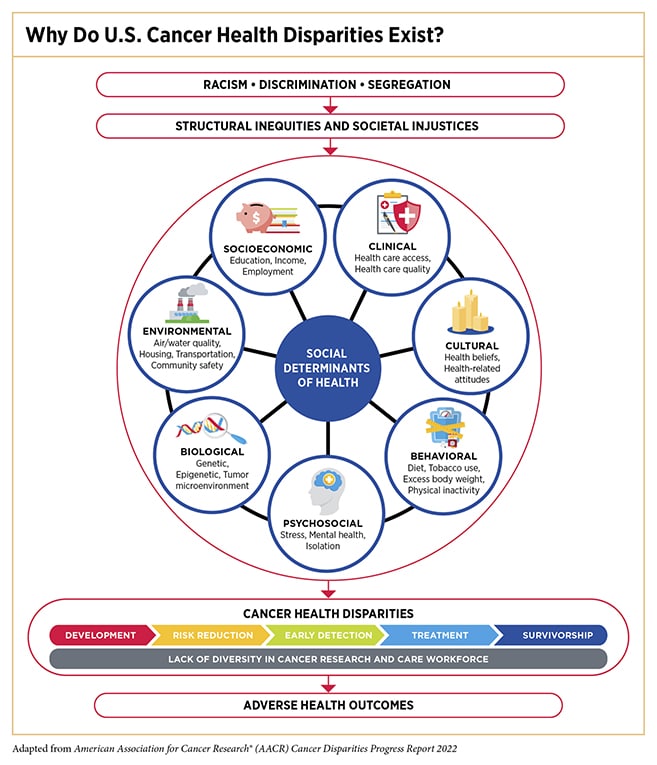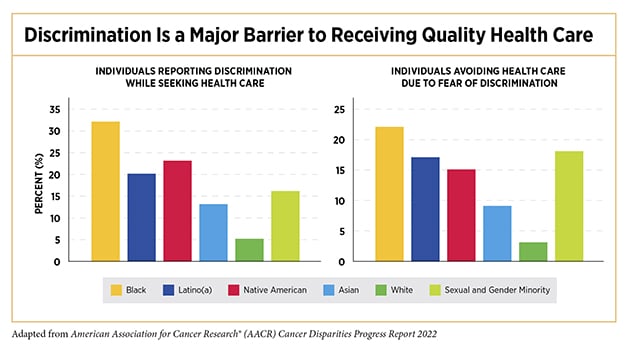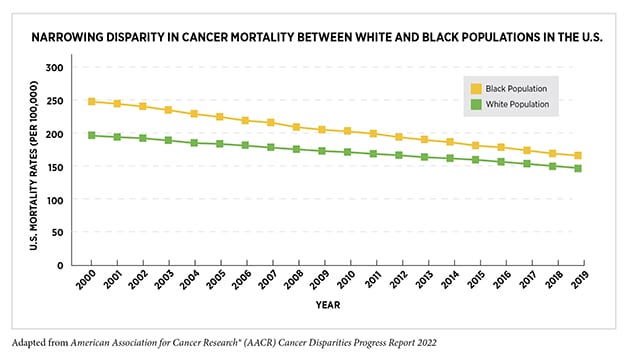AACR Report Shines Light on Cancer Health Disparities
At the age of 40, Marlena Murphy was diagnosed with triple-negative breast cancer, an aggressive subtype that occurs twice as often in Black women as in white women.
Her treatments, which included chemotherapy, surgery, and radiation, took an emotional and physical toll. Today, five years after her diagnosis, she is enrolled in graduate school to pursue a degree in counseling and has become a passionate advocate. Among other issues, she works to encourage Black patients to consider enrolling in clinical trials of cancer drugs. To date, only about 7.3 percent of participants in U.S. phase I cancer clinical trials are Black, compared with 84.2 percent who are white.
“Talking with people about clinical trials and showing them that there is a benefit, you’ll find more people wanting to get educated and participate in clinical trials. But it’s going to take a person who looks like us to say, ‘This is why you should do a clinical trial’,” Murphy said.
Today, the American Association for Cancer Research (AACR) released its Cancer Disparities Progress Report 2022, aiming to raise awareness of the enormous toll that cancer exacts on racial and ethnic minorities and other medically underserved populations, while highlighting areas of recent progress.
As the report explains, complex and interrelated factors called social determinants of health have a major impact on people’s well-being and quality of life. These factors encompass social, economic, and physical conditions in a person’s environment. In the United States, these social determinants of health have been influenced by a long history of racism and other structural, social, and institutional injustices that perpetuate cancer disparities for racial and ethnic minorities and other medically underserved populations. These graphics from the report highlight the roots of cancer health disparities and the toll discrimination takes on cancer patients.


As the report reveals, cancer disparities affect numerous groups, across many cancer types. Key examples:
- Both incidence and mortality rates for multiple myeloma in the Black population are at least twice as high as rates in the non-Hispanic white (NHW) population.
- The Hispanic population has a mortality rate of liver cancer that is nearly double that of the NHW population.
- The incidence rate for kidney cancer in the American Indian/Alaska Native population is 80 percent higher compared to the NHW population. This group also has the highest liver cancer incidence rate of any major racial or ethnic group in the U.S.
- Transgender men are more than twice as likely as cisgender men to be diagnosed with cancer.
- Residents of low-income areas share a disproportionate burden of cancer deaths. In persistently poor counties, mortality rates were 12.3 percent higher for all cancer types, and more than 40 percent higher for stomach cancer, when compared to counties that are not persistently poor.
- Compared to those living in urban areas, individuals living in rural areas have 17 percent higher death rates from all cancers combined, with 34 percent higher death rates from lung cancer and 23 percent higher death rates from colorectal cancer.
Signs of Progress
Despite these troubling disparities, there has been some progress in recent years. The report shows that the disparity in overall cancer mortality rates between Black and white people has narrowed from 26 percent in 2000 to 13 percent in 2019. The report describes multiple efforts to accelerate this progress, from culturally tailored screening programs to enhanced use of cancer registry data from AACR Project GENIE and the National Institutes of Health’s All of Us Research Program.

The quest to end cancer health disparities is personified by the cancer patients and survivors who graciously shared their stories in the Cancer Disparities Progress Report 2022. This video features a look at the obstacles faced by several different underrepresented groups, and shares how patients and survivors are working to break down barriers for future patients.
The report also provides specific recommendations for achieving health equity, which is a basic human right for all people regardless of their race, ethnicity, sexual orientation, gender identity, socioeconomic status, or community in which they live. Learn more about the AACR’s Call to Action in the full report.



